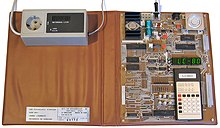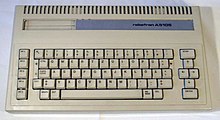Learning computer

A learning computer is a computer in which the pedagogical aspects are in the foreground. Originally it was about construction kits that conveyed the structure and function of a computer, nowadays the term mostly describes small computers for children on which special learning programs run.
development
Educational computers have been offered at relatively affordable prices , often as kits , since the late 1940s . These were initially often only available in the USA. With a kit, the learning success was particularly great because you had to pick up each component once. The understanding of the computer hardware was thus promoted.
In Germany, in 1968, logicus , a learning computer published by Kosmos-Lehrmittelverlag, was available; Devices such as the EZ80-DIT and PROFI-5 microcomputer family followed. From 1969 the Piko dat was available in the GDR. In 1981 the GDR manufactured the LC80 and in the following years a. the Kosmos CP1 , Polycomputer 880 , Know-how-Computer , NDR-Klein-Computer and Robotron BIC A 5105 offered. With the production of affordable high-volume computers for home use in the early 1980s, the classic educational computer was pushed back more and more.
Learning computers for children are used today for B. manufactured by the company Vtech . With this type of learning computer, however, the technology tends to take a back seat. On these small computers specially adapted for children, various learning programs run, e.g. B. to promote general knowledge or mental arithmetic.
Computer games with virtual learning computers are still a young development . For example, the open-world game Minecraft can be upgraded with the ComputerCraft mod , with the aid of which the player can construct virtual computers and robots that can be programmed in the Lua scripting language . The Minecraft Mod RedPower 2 offers components for 6502 -like virtual computers that can be programmed in the 6502 Assembly or Forth languages.
timeline
(Selection)
The boundaries are often fluid, between learning computers, single-board computers, development systems, home computers, etc.
Experiment kits, kits, etc. Ä .:
| year | Manufacturer | Surname | CPU | successor | Remarks | image |
|---|---|---|---|---|---|---|
| 1949 | Edmund C. Berkeley | Simon | - (electromechanical) | - | relay | |
| 1955 | Edmund C. Berkeley | Geniac | - (mechanical) | Tyniac Weeniac Brainiac (1958) |
Turntables |

|
| 1961 | Scientific Development Corp. | Minivac 601 | - (electromechanical) | - | Relays, switches |
|
| 1968 | cosmos | Logic | - (mechanical) | LOGIX, Piko dat | Sliders, wire bridges |
|
| 1969 | COMSPACE | Arkay CT-650 | - (mechanical) | - | Assembled version of the Paperclip learning computer , which consists of everyday objects (such as paper clips and tin cans), based on the book "How To Build a Working Digital Computer" from 1967 | |
| 1976 | RadioShack | Science-Fair Microcomputer Trainer | TMS1312 (4-bit) | Gakken GMC-4 (reissue 1981) | 20 keys, hex | |
| 1978 | Sharp | MZ-40K | 4-bit (custom) | MZ-80K (computer) | Single-board experimental computer | |
| 1981 | bush | microtronic 2090 | TMS1600 (4 bit) | 2188 computer technology | 24 keys, hex | |
| 1983 | cosmos | CP1 | Intel MCS-48 (8 bit) | - | Membrane keyboard, pseudo processor commands |
|
| 1983 | Philips | 6400 Microcomputer Master Lab | INS8070 (8 bit) | - | Cassette interface |
Training computer / industry:
| year | Manufacturer | Surname | CPU | successor | Remarks | image |
|---|---|---|---|---|---|---|
| 1976 | ITT | MP experimenter | Intel 8080 (8 bit) | - | Slide switches, keyboard hex, lamps, stencils | |
| 1976 | RCA | COSMAC microtutor | CDP1801 (8 bit) | Microtutor II (1977) | rocker arm | |
| 1977 | Christiani publishing house | Microprocessor system 85 | Intel 8085 (8 bit) | - | Module / rack design | |
| 1978 | Christiani publishing house | SC / MP teaching computer | SC / MP (8 bit) | - | Circuit board kit | |
| 1978 | Kammerer engineering office | EZ80-DIT | µPD8080A (8 bit) | - | Single board computer, buttons, rocker arms |
|
| 1979 | BFZ Essen | Microcomputers for training MFA | Intel 8085 (8 bit) | - | Module / rack design |
|
| 1979 | Siemens | ECB85 | Intel 8085 (8 bit) | - | Single board computer, keyboard, hex, breadboard |

|
| 1981 | Kammerer engineering office | PROFI-5 | Intel 8080 (8 bit) | MICO-80 (Z80), PROFI-5E | Single board computer, 25 keys, hex |
|
| 1983 | VEB Polytechnik | Polycomputer 880 | MME U880 (8 bit) | - | Case, cassette interface |
|
| 1983 | SEL | Z80 trainer | Zilog Z80 (8 bit) | DAG technical center MP learning system (1988) | Case, slide switch, buttons LEDs | |
| 1984 | VEB Microelectronics Erfurt | LC80 | MME U880 (8 bit) | - | Single board computer |
|
| 1986 | DATANorf | WDR 1-bit computer | Motorola MC14500 ( 1-bit ) | - | Multi-board kit | |
| 1989 | robotron | BIC A 5105 | MME U880 (8 bit) | - | Home computer, educational computer |
|
Development systems / training kits:
| year | Manufacturer | Surname | CPU | successor | Remarks | image |
|---|---|---|---|---|---|---|
| 1976 | NEC | TK-80 | μPD8080A (8 bit) | - | Single board computer, keyboard hex |
|
| 1976 | Heathkit | ET-3400 | Motorola 6800 (8 bit) | - | Keyboard, hex, breadboard |
|
| 1976 | Rockwell | AIM-65 | 6502 (8 bit) | AIM-65/40 | Home computers |

|
| 1976 | Texas Instruments | LCM-1001 | SBP0400 (4 bit bit slice) | - | Rocker arms, lights |
|
| 1981 | Microtech | Microprofessor I. | Zilog Z80 (8 bit) | MPF-I Plus | Single board computer |
|
For other, general development systems, see System Design Kit .
See also
Web links
- Robotron accessed June 24, 2011
- Computermuseum Munich, accessed on June 24, 2011
- Der Spiegel, 17/1979, accessed on June 24, 2011
Individual evidence
- ↑ ComputerCraft
- ↑ RedPower 2 Mod 1.7.4 for Minecraft 1.7.4 ( Memento of the original from February 1, 2013 in the Internet Archive ) Info: The archive link was inserted automatically and has not yet been checked. Please check the original and archive link according to the instructions and then remove this notice.
- ↑ How To Build a Working Digital Computer , the complete book as a PDF file; See also How to Build a Working Digital Computer ... out of paperclips , evilmadscientist.com, accessed on October 15, 2017

